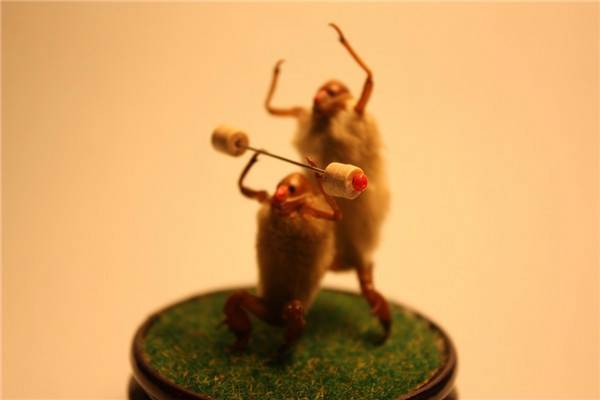Hairy Monkey 毛猴
Dublin Core
Title
Hairy Monkey 毛猴
Subject
Insect Toy, Folk culture
Description
The Hairy Monkey was probably invented in Beijing during the Qing Dynasty. The most common Hairy Monkey sculptures feature dancing or posturing monkeys.
Date
Qing Dynasty (1644-1911 AD)
Format
Small, Furry
Type
Craft
Crafts Item Type Metadata
Crafting Methods
With Magnolia buds used for making its body, cicada torso used for the limbs, and cicada antennae used for the tail. They do it by taking magnolia buds gathered in early spring, when they are covered with a fluffy down, and attaching the heads and legs of cicada carapaces – resembling minuscule lobster claws – which the insects shed in high summer and leave on the trunks of the trees in which they live.
Bending these claws into arms and legs, the artists then set the miniature monkey-like figures in old-fashioned Beijing street scenes, selling toffee apples, playing Chinese checkers, sharpening knives, or grilling lamb kebabs, and place the decorative tableau under glass domes for protection.
Bending these claws into arms and legs, the artists then set the miniature monkey-like figures in old-fashioned Beijing street scenes, selling toffee apples, playing Chinese checkers, sharpening knives, or grilling lamb kebabs, and place the decorative tableau under glass domes for protection.
Materials
Magnolia buds, Cicada
Usage and Application
Modeled on human actions and scenes from daily life, the handicrafts vividly represent urban life and customs, like barbers, fortune-tellers, hawkers of sugarcoated haws on a stick and so on. Some of the handicrafts form a complete set of artworks, such as "The County Magistrate on Inspection," and "Marriage Series," which were sometimes available at the stalls of temple fair and in the Dong'an Market as well as some toyshops in Quanye Department Store.
In recent years, additional creations of this handicraft, which, while sticking to the traditional subjects, also reflects the real modern life.
In recent years, additional creations of this handicraft, which, while sticking to the traditional subjects, also reflects the real modern life.
Interesting Facts
The creation of hairy monkeys was quite an accident. In the late Qing Dynasty (1644-1911 AD), there was a drug store named "South Qingren Hall". One day, two assistant chemists in the store, while fiddling with some Chinese medicine, worked out a small monkey-like toy with a shed cicada skin, a hairy white magnolia bud, a bletilla striata (the stem of a kind of plant) and an akebi (another kind of plant).
Their accidental creation caught the attention of the shopkeeper, who then suggested selling the four Chinese medicines in a pack as raw materials for making such toys. Hairy monkeys then became popular as a folk handicraft, but were limited among the small number of folk artists and the banner men ("Banners" is the military organization of the Qing Dynasty).
Though the raw materials are quite simple, the artists are capable of designing exquisite patterns through their observation and perceptual knowledge of a wide range of images. By using the hairy magnolia bud as the body, and adhering the head and claws cut from the cicada to it, they can create artworks of various kinds of shapes and postures.
Their accidental creation caught the attention of the shopkeeper, who then suggested selling the four Chinese medicines in a pack as raw materials for making such toys. Hairy monkeys then became popular as a folk handicraft, but were limited among the small number of folk artists and the banner men ("Banners" is the military organization of the Qing Dynasty).
Though the raw materials are quite simple, the artists are capable of designing exquisite patterns through their observation and perceptual knowledge of a wide range of images. By using the hairy magnolia bud as the body, and adhering the head and claws cut from the cicada to it, they can create artworks of various kinds of shapes and postures.
Collection
Citation
“Hairy Monkey 毛猴,” CCCH9051 Group 64, accessed January 3, 2026, https://learning.hku.hk/ccch9051/group-64/items/show/42.

